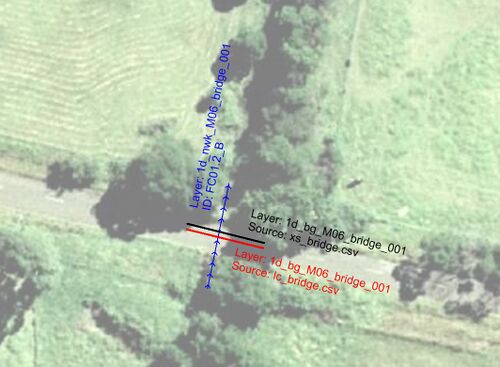Tute M06 Arc 1D2D bridge Archive
Jump to navigation
Jump to search
The following steps are used to create the replacement 1D bridge channel - 1d_nwk - that will represent the bridge in the 1D domain.
Method
- Make a copy of the layer 1d_nwk_M04_culverts_001_L located in the TUFLOW\model\gis folder and save as 1d_nwk_M06_bridge_001_L.
- Add the newly saved layer to the ArcMap window and start editing. Right click on the 1d_nwk_M06_bridge_001_L layer in the Table of Contents and open the attribute table.
- Locate the entry for the feature labelled with ID FC01.2_R. Select the other two features within the layer and delete the selected features. Only the feature with ID FC01.2_R should remain.
- Update the attributes of the remaining feature as follows. Note that Type B stands for Bridge. Similar to the open channel developed in Tutorial M04, setting the upstream and downstream invert attributes to -99,999 means that TUFLOW will take the elevation values from the the cross section (or, in this case, bridge section, attached to the line.
- Note that the data entries for the other attributes are not used for the Bridge type structure (Len_or_ANA, n_or_n_F, Width_or_D, Height_or_, Number_of, Height_Con, Width_Cont, Entry_Loss and Exit_Loss). However, to avoid confusion it is recommended that these other attributes be cleared. Delete the data entry for the other attributes not used for the Bridge type structure.
We have changed the in-channel structure to a bridge. Therefore, we have updated the feature ID attribute to FC01.2_B.
Save your edits. - Copy the ‘bg’ folder (and contents) located in Module_Data\Module_06\ArcGIS\1D_Bridge and paste it in the TUFLOW\model\ folder. This folder contains the bridge cross section csv file, bridge form loss csv file and the shapefile that connects the bridge cross section to the 1d_nwk_M06_bridge_001_L layer. It also contains the weir geometry csv that we will use later for Bridge Modelling Option 2.
- Open the 1d_bg_M06_bridge_001_L layer in ArcMap and use the Identify tool to observe the attributes. The 1d_nwk and 1d_bg layers are pictured below. The two polylines intersect the 1d_nwk feature. The Source attribute controls the data used to define the bridge cross section (type 'HW', shown in black) and loss coefficient table (type 'LC', shown in red). Note that there is no need to define the elevation of the bridge soffit. TUFLOW will automatically assume this is the highest (last) elevation within the cross section table.
- Make a copy of the layer 1d_nwk_M04_culverts_001_L and save as 1d_nwk_M06_culverts_001_L in the TUFLOW\model\gis folder.
- Open the newly saved shapefile in ArcMap and start editing. Use the Identify tool to locate the feature with ID FC01.2_R. Select and delete the feature, these were the culverts that were previously in the location where our bridge currently is. Only the two other structures that we are not changing should remain. We now have two 1d_nwk layers, one with just the new bridge (1d_nwk_M06_bridge_001_L) and one with the existing culverts that will remain(1d_nwk_M06_culverts_001_L). Note that you could include both the bridge and the culverts in the same 1d_nwk layer but it is common modelling practice to divide them up by structure type
- Save your edits and stop editing.
| Attribute | Value |
|---|---|
| ID | FC01.2_B |
| Type | B |
| Ignore | F |
| UCS | T |
| US_Invert | -99999 |
| DS_Invert | -99999 |
 While we are replacing the culverts at one of the structures, we still need the other two culvert structures present in the model area. We are therefore going to create a copy of the 1d_nwk shapefile containing the other culverts that can be read into the model.
While we are replacing the culverts at one of the structures, we still need the other two culvert structures present in the model area. We are therefore going to create a copy of the 1d_nwk shapefile containing the other culverts that can be read into the model.
Conclusion
The replacement 1D bridge and modified 1D culvert layers have been created to model the new bridge on the northern road. Please return to the main page of module 6.